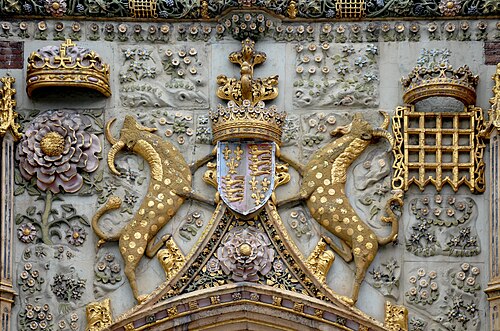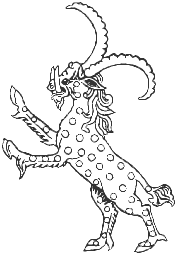Yale (mythical creature)
This article includes a improve this article by introducing more precise citations. (February 2016) ) |


The yale or centicore (
Etymology
The name "yale" is believed to be derived from the Hebrew word יָעֵל (yael), meaning "ibex". Other common names are "eale" or "centicore". The Septuagint translation of Job 39:1 rendered the word יָעֵל as τραγελάφων (trageláphōn), which referred to the mythical tragelaphus, a half-goat half-stag, which in 1816 gave its name to a genus of antelope Tragelaphus.
Description
The yale is described as an antelope- or goat-like creature with the tusks of a boar and large horns. These horns possess the ability to swivel in any direction which makes them good for both offensive and defensive attacks.
The yale was first written about by
it is the size of the river-horse, has the tail of the elephant, and is of a black or tawny colour. It has also the jaws of the wild boar, and horns that are moveable, and more than a cubit in length, so that, in fighting, it can employ them alternately, and vary their position by presenting them directly or obliquely, according as necessity may dictate.[1]
Pliny reports sighting the yale while on the sub-Saharan African plains. The antelope and buffalo inhabit this region and loosely match his description, so may have given rise to his misunderstanding.
The yale subsequently featured in medieval bestiaries and heraldry.
Heraldry

The yale is among the heraldic beasts used by the
Lady Margaret Beaufort was a benefactor of
In the US, the yale is associated with Yale University in New Haven, Connecticut. Although the school's primary sports mascot is a bulldog named Handsome Dan, the yale can be found throughout the university campus. The mythical beast occupies two quadrants of the coat of arms of the Yale Faculty of Arts and Sciences (FAS). The yale is also depicted on the official banner of the president of the university, which, along with a wooden mace capped by a yale's head, is carried and displayed during commencement exercises each spring. Yales can also be seen above the gateway to Yale's Davenport College and the pediment of Timothy Dwight College.[3]
References
- ^ Bostock, John; Riley, H. T., eds. (1855). The Natural History of Pliny. Vol. 2. London: Henry G. Bohn. pp. 279–80.
- ^ "Royal beasts - The Royal Mint Museum". The Royal Mint Museum. Retrieved 28 May 2025.
- ^ "The Queen's Beasts - The Yale of Beaufort". Chards. Retrieved 28 May 2025.
Further reading
- Carol Rose, Giants, Monsters, and Dragons: An Encyclopedia of Folklore, Legend, and Myth, (2000) ISBN 0-393-32211-4.
- Donna M. Hrynkiw, The Yale: Heraldic Beast (August 20, 1998).


